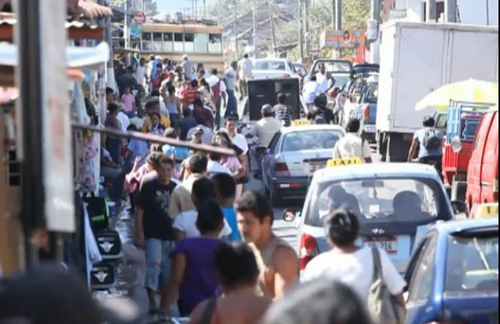También disponible en español
Behind Latin America’s economic boom is hidden a wave of crime and violence, hurting all citizens, particularly the poorest, who have no way of protecting themselves.
Citizen insecurity has a variety of complex causes, ranging from organized crime, to outdated, ineffective justice and law enforcement systems, to domestic violence, which affects one in three women worldwide.
In Latin America, crime and violence have already reached “epidemic” levels – more than 10 homicides for every 100,000 inhabitants by World Health Organization standards.
To put this figure in perspective: Spain, with 47 million inhabitants, has an average of 400 homicides per year; by contrast, Central America, with a population of 41 million, reports 18,000 violent deaths annually. All the minutes of silence for those victims combined do not even come close to equalling the amount of time lost by the region and affected households.
In an alarming twist, violence is now threatening the region’s social and economic advances of recent years – a growing middle class and a sharp decline in poverty. I’m afraid that citizen insecurity is becoming the Achilles’ heel of development.
The costs for the region are enormous. In Central America law enforcement, security and health expenses derived from crime and violence represent 8% of the sub-regional GDP (public and private spending).
In Jamaica, to cite just one country example, this figure is 3.7%. Intangibles costs are more difficult to measure, but we can still fathom their enormity. How can we tell what would have been the contribution to society of young people whose lives were cut short by violence? Other costs, which are also difficult to work out, are part of the disturbing tear in the social contract resulting from citizens’ lack of trust in the government’s ability to defend society.
Recent surveys show that the number of Latin Americans citing crime as their main concern has tripled over the past decade. Fear causes them to withdraw, to hide behind gates and avoid public spaces, which ultimately weakens the interpersonal ties, which form the foundations of society.
The problem is a difficult one because its roots are complex and multifaceted. Drug trafficking, youth and gang violence, the lack of educational opportunities, abundance of firearms and weak justice and law enforcement systems are only some of the causes of crime and violence, particularly in Central America.
Response on several fronts
What can we do about this problem? At the World Bank, we decided to take a closer look at the phenomenon, to conduct exhaustive analyses to better understand the issue and address its roots. A broad based study on crime and violence in Central America was published in 2011 noting that the region's achievements are being undermined by this issue. The study concludes that the problem requires an integrated response. In addition to law enforcement, efforts should focus on prevention and engaging all sectors of society.
The private sector is crucial to this effort due to its capacity to create jobs. Obviously, the government must fulfill its role in applying the law and creating education and employment opportunities to bring all Latin Americans closer to the goal of shared prosperity.
However, I also believe that the private sector has much to contribute in terms of improving citizen security.
Creating jobs for young people can alleviate one of the factors that exacerbate violence: in other words, the lack of opportunities for at-risk youth -school dropouts, teens exposed to violent environments, drugs or gangs.
We are all in the same boat, and we must all row together. Setting aside their own agendas and branding, multilateral organizations – such as the UN, OAS, IADB and us –are providing support to strengthen regional security strategies.
One noteworthy initiative is the proposed creation of a regional crime observatory that compiles statistics and data to facilitate understanding of and actions against this issue.
We must also work more closely with communities. In Honduras, for example, the World Bank recently approved its first citizen security operation – the Safe Municipalities Project, which focuses on the active participation of multiple social sectors in identifying solutions to violence. Further south, violence also makes the headlines.
Naturally, it is also a leading topic of conversation on social networks and around the family dinner table.
The World Bank recently published a study that reveals the two faces of violence in Brazil: on the one hand, the growing crime statistics in the country, and, on the other, Brazilian authorities’ successful prevention efforts. Once protagonists of Hollywood B movies and violent video games, the favelas (urban slums) now have a more hopeful, less violent future thanks to an ongoing peace process.
Police Pacification Units (UPP), which also provide social services, have greatly improved life in these neighborhoods. Today, there are 28 UPP in some 100 favelas, where 400,000 people live. As the report states, Brazil has become a type of initiative laboratory to reduce violence, which combine control measures with prevention activities.
My hope is that these experiences – in Brazil and in Central America – inspire new initiatives to help stem violence in the rest of Latin America and to keep the region on the path to inclusive economic development. This is neither an easy nor a short-term task.
To be successful, planning must engage society as a whole and focus on prevention of risk factors. In addition, public policies should be evidence-based.
Finally, the government is ultimately responsible for ensuring security for everyone.



Join the Conversation